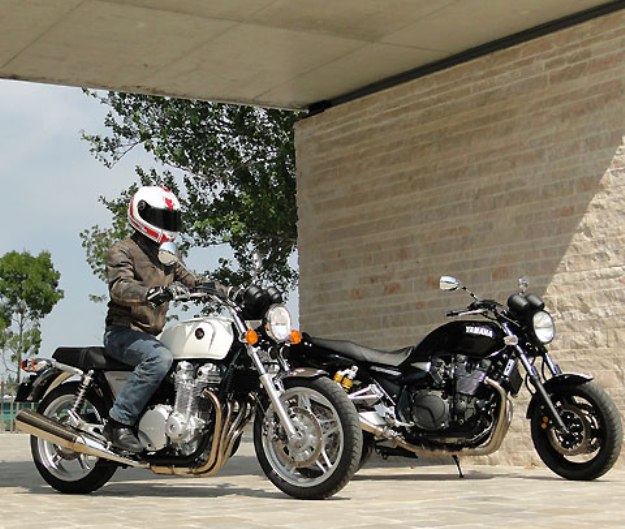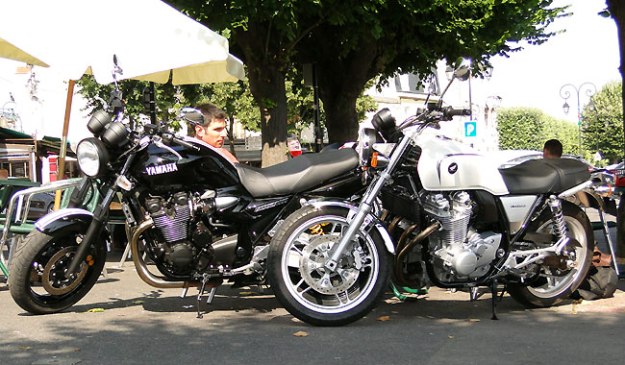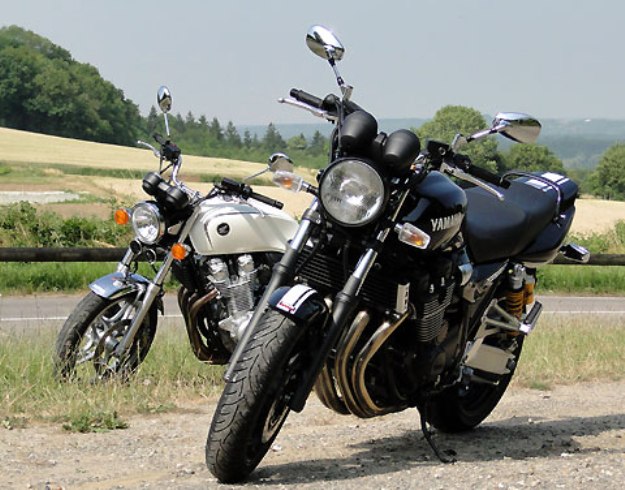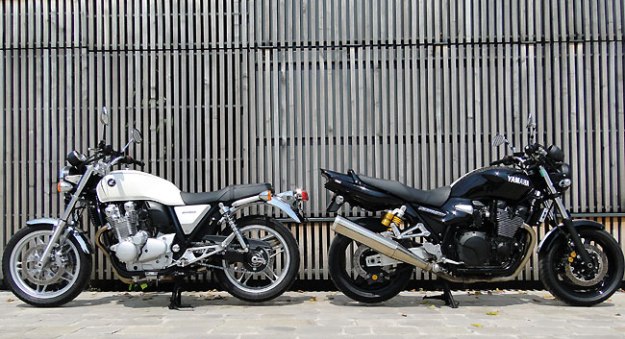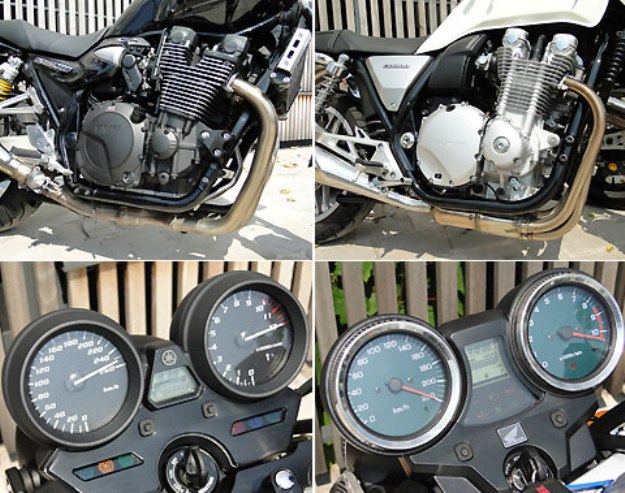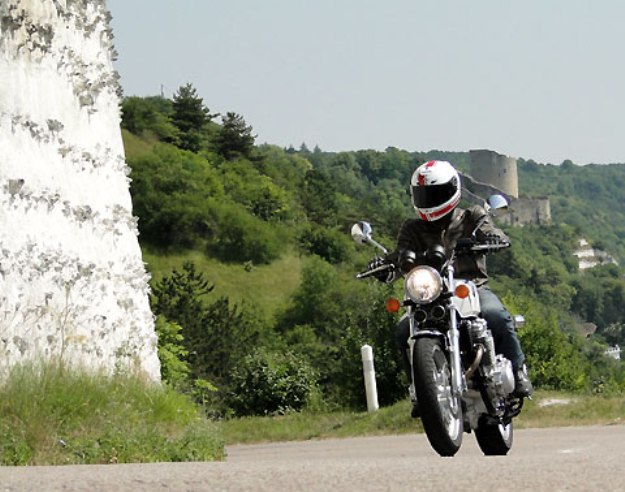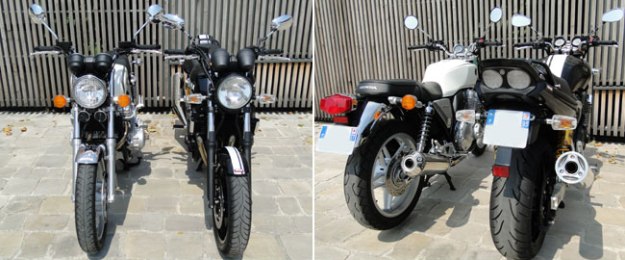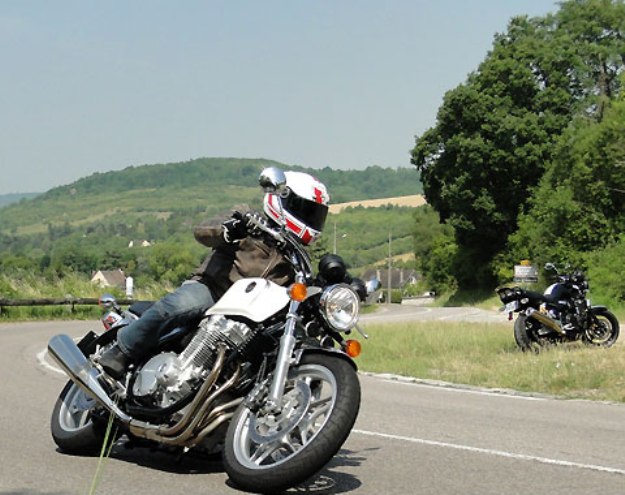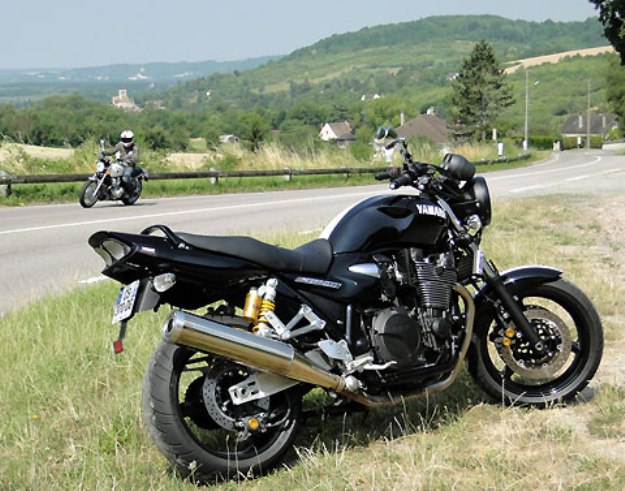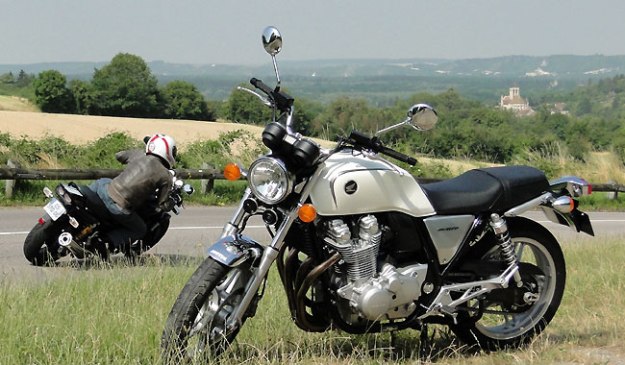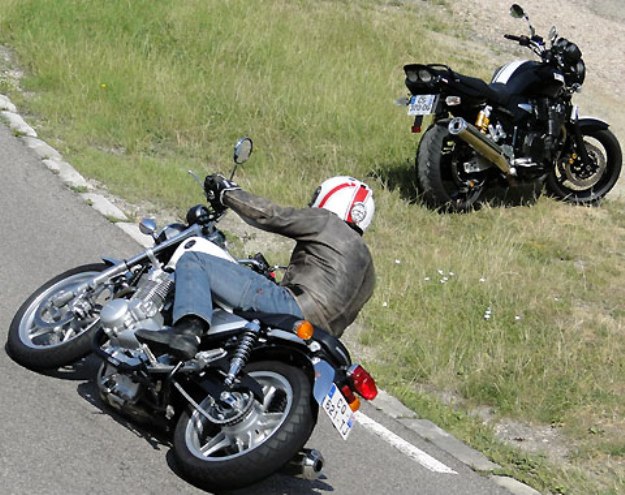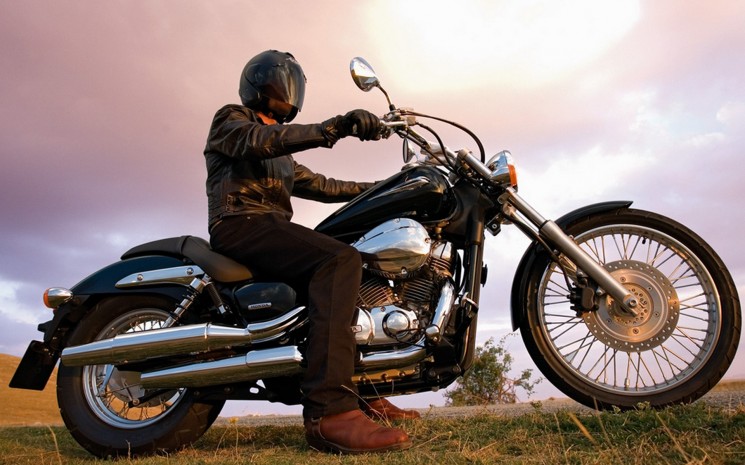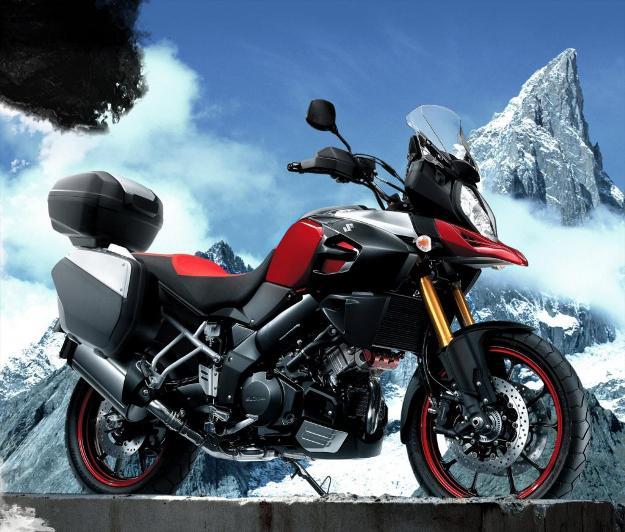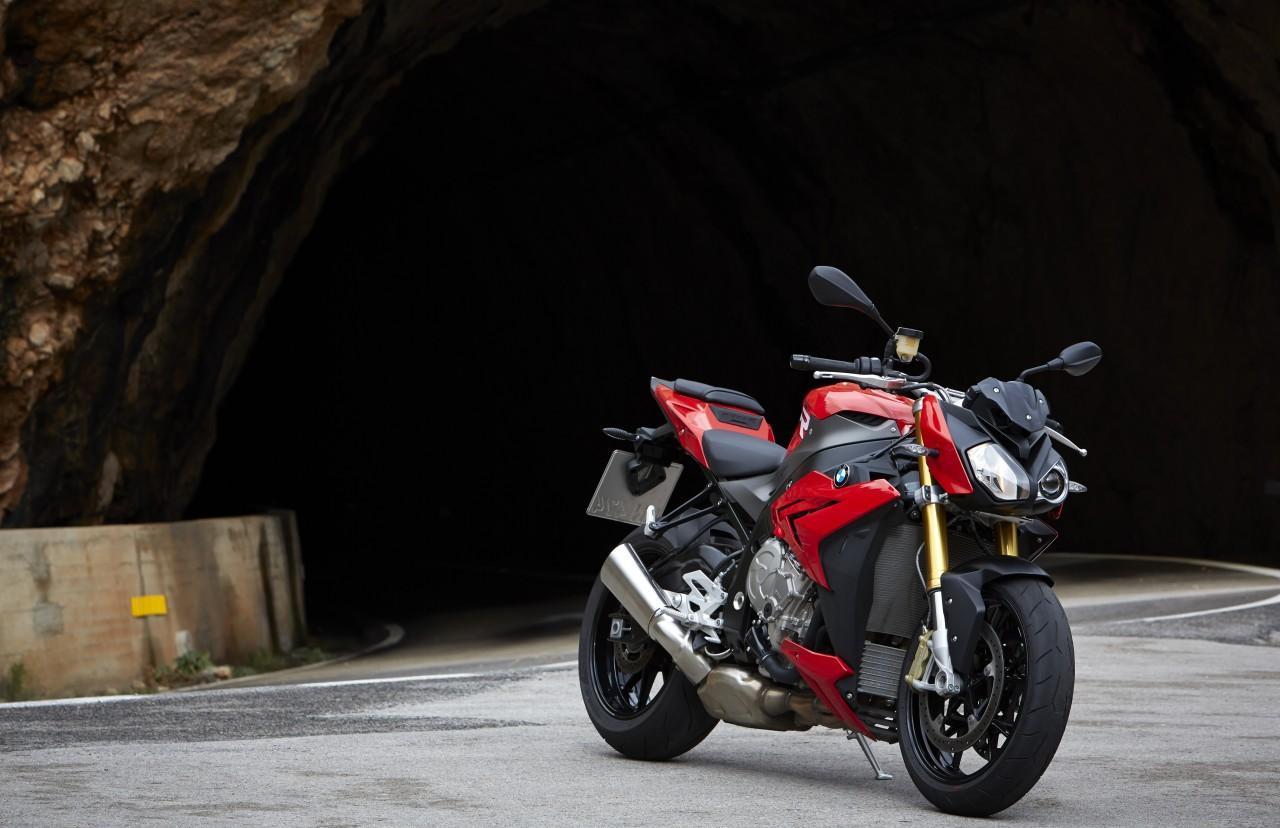One is a modern motorcycle designed “to the old”, the other a roadster to beautiful remnants become a classic. The Honda CB1100 Vs Yamaha XJR1300 continued the same objective: charmed the biker with nostalgic sensations of the past.
Honda CB1100 Vs Yamaha XJR1300 Oh, Grandpa Day!
Artificially aged clothing, automobiles inspired by past successes (Fiat 500, Volkswagen Beetle, etc..), Indoor ‘old school’ decorations … Whatever the field, making new and imitating the former became a trend. The motorcycle production does not escape this phenomenon, especially as it echoes the increase in the average age of the biker: even if some young people today are ‘vintage’ what was called the ‘corny’ yesterday, it is a mature clientele that is intended primarily a neo-retro as the Honda CB1100 2013.
Impossible indeed not to dive back 45 years detailing its flat saddle, its reservoir lying back, its frame double cradle, its combined shock absorbers, its narrow tires, its round headlight, and especially its four-cylinder in-line cooled by air-oil: the Honda CB1100 stirs nostalgia rope in inspired openly the CB750 Four!
Discovery as a concept in Tokyo in 2007 and three years later sold only in Japan and Australia, this ‘false old’ has a breakneck pace. His secret a technical and aesthetic simplicity which refers to the bulk of the bike: a handlebar, two wheels, a (big) engine, and just! Damage to quad exhaust outlets has not been chosen to accentuate the parallel with the cult ‘ 4-pots’. Visually, its bare back there would have also won in equilibrium.
The presence of stick rims grieve also those who ‘know a RADIUS’, just like keys plastic scattered here and there (cabochons of flashing lights, meters, and headlamp support rear, especially). Apart from these details, the bike is a pure success stylistic, coupled with a brilliant demonstration of ‘knowledge-good-how’ Honda: look back and forth with delight between the top unreleased engines surrounded by fine 2 mm Wing – the lower part, it comes from the CB1300 – and beautiful parts like the footrest plates cored.
Assembly does not suffer from defects, surface treatments are cared for (especially the chrome fenders) and the integration of the electric network is conspicuous by its discretion. Even the installation of a small 335 mm in front of the cylinder oil cooler has been the subject of enough attention so as not to disturb the line.
In short, Honda has neat packaging to maintain the illusion: despite its novelty status in 2013, the Honda CB1100 exudes true flavors of the past. Only the C – ABS braking (combined from the rear towards the front), its coded key, its catalyzed exhaust, injected PGM – FI, and digital screen (with clock, gauge petrol, and trips) placed between its legible meter and tachometer needle betray its modern design.
Authentically old
Face it, the Yamaha XJR1300 is driven by mechanical. And not only because it’s 98 hp and 108.4 Nm giving him the mechanical advantage (87.9 HP and 93 Nm for the Honda)! The Yamaha has especially something that the fireworks of its rival only suggest: a status of authentic, old. A distinction which has nothing of innocuous to some fans of the genre…
The comprehension of its motor, for instance, goes back up to the originator of the saga: XJR1200 of 1995. Up to the arrival of the Honda CB1100, this big block was the last representative of ‘4-legs’ Japanese cooled down by air on the market! Meantime, this engine of course evolved: it notably crossed 1188 direct currents in 1251 direct current in 1999, left an exit of exhaust in 2002, and followed the evolution of norms by adopting a catalyst in 2004, then injecting three years later.
This conservatism is also evident in its chassis double cradle steel frame which has certainly strengthened over the years and suspensions won both rigor in setting possibilities, but the front brake calipers from always R1 1998!
Aesthetically, same fight: ‘designers did not want to change the image of this insensitive to the time machine and I bet that the vast majority of bikers will not see the difference without scrutiny’, joked same Yutaka Kubo, project manager of the XJR1300, upon the release of the 2002 vintage (the first serial the Ohlins dampers hitherto reserved for the SP version).
The most important stylistic change would involve five years later when round LED lights will appear in the rear seat raised nicely. Since 2007, the Yamaha XJR1300 has not changed the following year merely new colors and some graphical changes (the fork and swing arm dyed black in 2011, for example).
And so much the better would be tempted to write both lines have lost none of their charm! More sports – but more massive – than the Honda CB1100, style evokes the very first ‘Superbike’ with which American pilots were shooting the wad in the 70/80. Its polished fins and mousse oscillating aluminum arm reinforce this side of the racing of yesteryear while participating in the excellent perceived quality generated by the motorcycle.
As on the Honda, the finish is excellent and the quality of the materials inspires seriously. The unique flat comes from the alternator which exposes shamelessly to its copper coils… The instrumentation is also somewhat austere: strapping chrome around the counters is not displeasing to us.
Since 2004, the Yamaha XJR1300 has a key code, while its instrumentation also hosts a small digital window between its two counters. If this digital keypad exposes the same information as on the Honda (trips, clock, fuel level), it makes the smallness of its characters less readable while driving.
Thanks to the test, you here now trimmed to keep the spittoon for hours in the torque or during a gathering of old! But now those submissions are made if you spent riding the Honda CB1100 and the Yamaha XJR1300 to see what they have in the belly.
Return to the past…
Relatively thin in the crotch with the elongated shape and the low capacity of the tank (14.6 liters), the Honda CB1100 is easily mounting. Branches identified to handle the bust, the footrests low-placed and responsive driving suspensions under the weight of the driver immediately set the tone program promotes relaxation in Bastard!
However, several details of questionable design – quite rare with Honda – dull table… The saddle is first frankly uncomfortable: a few tens of kilometers are sufficient to highlight the firmness of its padding and the inadequacy of its maintenance. The long steps will be necessarily punctuated by ‘breaks-ass’!
Secondly, the setting of the distance of the brake before is not accessible – because under the accelerator cable-, while the deployment of the side stand suffers from poor positioning of the hook: too high, it does not provide sufficient lever arm. As the installed central series, that of our test model sometimes a little help asked to withdraw completely into its housing…
Finally, if the passenger handles in the form of notches in the saddle treat aesthetics, it is not without consequences for the comfort and convenience dug into the skin, they quickly become unfriendly to the fingertips, while their small size makes them easily graspable with big gloves.
The Yamaha XJR1300, the passenger has a wide and accessible handle placed behind his back and especially an incomparably softer seat. This is a true sofa two-seater that Yamaha offers the driver and his guest! The calibration of handsets Ohlins being instead of the flexible kind, comfort to stop extends Dynamics: irregularities in the bitumen are barely felt, like on a good road bike.
However, despite an identical seat height (765 mm), the Yamaha ‘does not offer the same accessibility as the Honda’s legs are further apart because of the engine and especially the larger tank (21 liters). The position is also a sportier suspicion because the footrests are more remote and the handlebar – closer – is slightly less pointed.
Like the Honda CB1100, the Yamaha XJR1300 series has a center stand, which requires significantly more effort to be deployed. Yamaha has good weigh lighter than the Honda (245 kg fully fueled announced against 248), the overweight is more sensitive during handling to stop wandering and low speed.
Leveraging its narrow air rises (110 mm front and 140 rear and 180 mm against 120 on Yam), a better weight distribution, and a center of gravity less above, the Honda CB1100 seems to weigh 50 kg less than its rival at very low speed. Like a beautiful woman, the curves of the Honda did not serve because they were well placed!
In the rear-view mirror of Yamaha!
Then comes the time to pay more attention to the engines. For a retro roadster, this is a mouth, but also (especially?) Mill! Here, the search for maximum performance is not an end in itself feelings take precedence over performance, ‘safe’ is more important than sheer power and character takes precedence over speed.
Seen through this mechanical Prism, the charm of the Honda CB1100 knows the business, alas, a setback… First disappointment: the soundtrack is not up to the motorcycle’s plastic. But the most frustrating aspect comes from the melody itself: the engine ‘sounds’ like a 4-cylinder modern, his growling evoking instead the CBF1000F than the CB900 Bowl of Gold.
If it shines by its availability (exiting fifth less than 1000 RPM is a formality) and his consistent reminders, the Honda block appears to police generally. Emotion is not at the rendezvous, the fault of gradients in diet without plume, because too linear…
Fans of ‘cotton wool’ more than ‘Watt’, the Honda CB1100 will fill you: the injection is perfectly calibrated; the selection is accurate, while amazing mechanical elasticity allows driving on the very pleasant couple. The only wrinkles from disturbing this ocean of softness are the tingling felt between your thighs the acceleration and the – very – light Jolt noticeable resumption of fillet of gas transmission.
From kickoff, four cylinders of Yamaha eclipse his rival: Yamaha XJR1300 snorts in a deliciously husky, lightly irregular tonality with cold, before whirring mightily. At a slower pace, meters and mirrors of rear-view mirrors (less efficient than those of Honda) vibrate merrily to the rhythm of the heartbeats of the motor. This prickle stretches up to handles and tickles the emotional feet at around 4000 RPM.
Despite its more square ribs (79 x 73.5 x 63.8 mm against 67.2 mm for the Honda CB1100), the Yamaha block takes its towers with more inertia and offers – logically – more engine brakes when downshifting. A little less flexible than its rival, the Yamaha XJR1300 resumes idling at less than 20 km / h in fifth overall and running the same schemes to 110 km / h on the last report, for example, the tachometer shows 3750 Honda rpm, one of the Yamaha 4000 rpm.
Hyper horsepower engine pushes especially much stronger and with more enthusiasm: you’d swear that a significant capacity gap separates the two motorcycles, while the Yamaha ‘that’ enjoys an advantage of 81 cc!
Whatever is diet or the hired report (via one limp louder and a firmer clutch than on Honda), the Yamaha XJR1300 dislocates his rival by making speak his upper couple and its leaf. While that of the Honda CB1100 seems to stagnate in the attack of high – schemes, the acceleration of Yamaha increases in effect practically up to its break located in 10 000 rpm (9000 on Honda).
So much so that the chassis is not always all that cash-mettle good ‘oldies’, the Yamaha does not like to be heckled and reveals its limits in intensive driving. Nothing to say about the plans of the braking and stability despite a relative lack of consistency in making the right lever, the four-piston calipers provide very convincing slowdowns, while the 1500 mm wheelbase (10 mm longer than Honda) gives it good tracking.
On the other hand, transfers of masses are less well absorbed than the Honda otherwise putting the cohesion of depreciation. Insufficiently withheld in hydraulic rear dampers is largely the origin of this phenomenon, which eventually leads to gait when they spin the right handle curves out. At the same time, having regard to the health of mollify, the rear axle is a damn updated contribution under these conditions!
The Honda CB1100, the less heavy steering and balance most successful entries allows more precise curves and angle changes effortlessly. While Yamaha tends to engage in low and medium speed, Honda has a perfectly neutral angle and the front end returns more information.
Comfortable, Honda has not forgotten to be rigorous excellent brake assist coupled to dose more easily and suspension work together from the beginning to the end of a turn. What a pity that a clearance is worthy of a chopper putting a mechanical brake ‘in this great potential …
Verdict victory Honda CB1100, favorite Yamaha XJR1300!
Under her – beautiful – the old tunes, the Honda CB1100 cache devices (C-ABS, modern injection coded key, etc…), and a ‘modern’ dynamic behavior. The result is particularly compelling, even exciting not only because the bike is as beautiful to look at and pleasant to drive, but also because the process is something refreshing…
No, Honda does not manufacture those pragmatic two-wheelers: the Honda CB1100 is proof, it was designed solely for the pleasure of the senses! Its only real flaws are looking at (in) comfort saddle and its engine not quite expressive. The tariff seems also too high (€10 990) concerning its technological simplicity: nostalgia is expensive to pay for the winged emblem…
Less expensive (€ 9,499, excluding specials on the previous year) and much more sensational mechanically speaking, the Yamaha XJR1300 is yet to lose to the homogeneity of its rival. His most clumsy and less rigorous dynamic behavior, as well as the absence of ABS, betrays its dated design.
Remains a fantastic engine and a line that ages well if the retro trend continues, could even regret Yamaha Suzuki and Kawasaki have stopped producing Fire GSX 1400 ZRX 1200!
